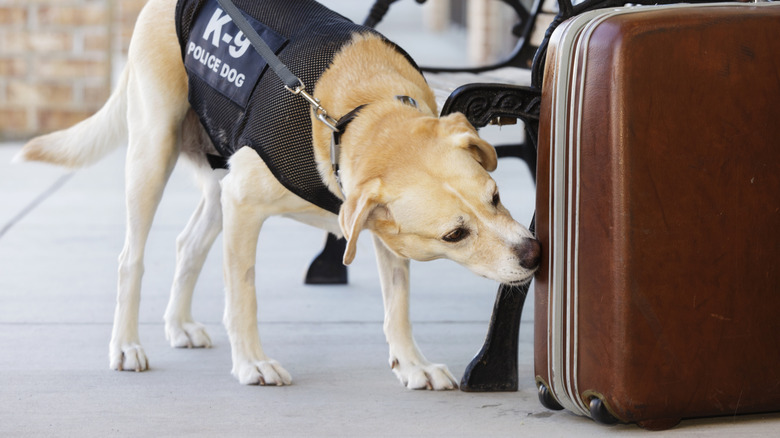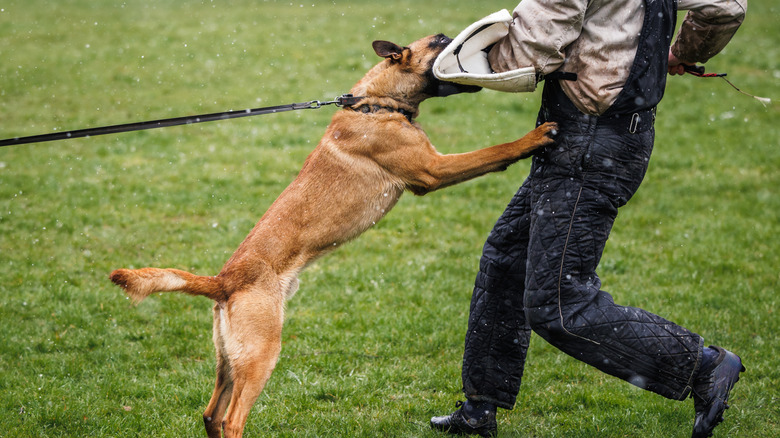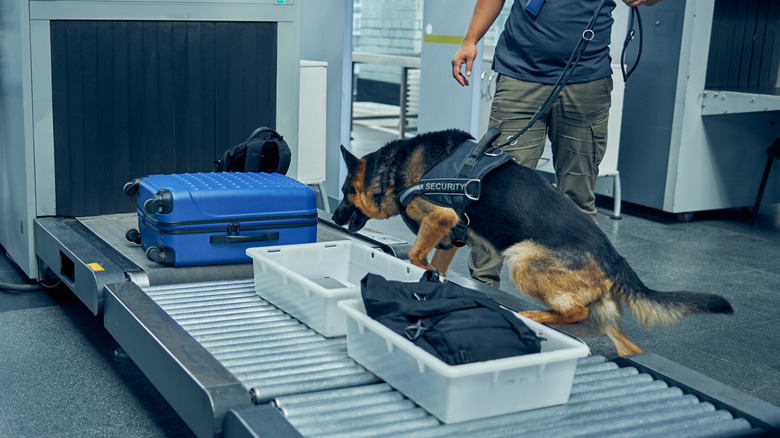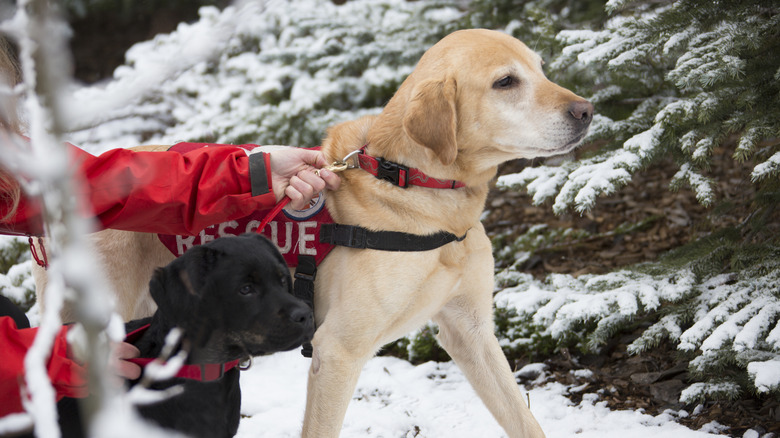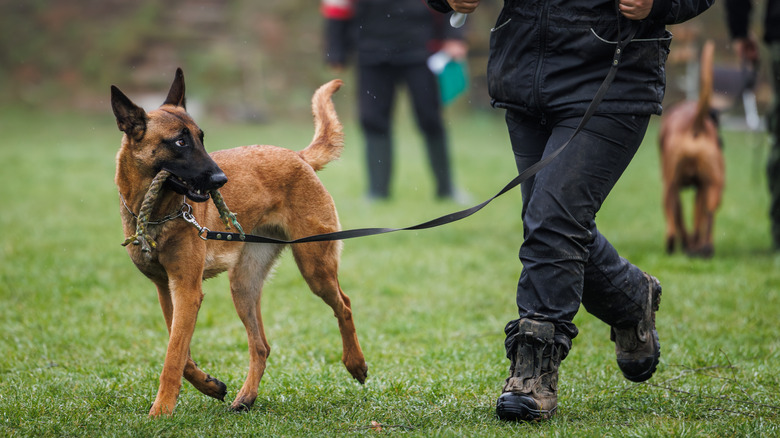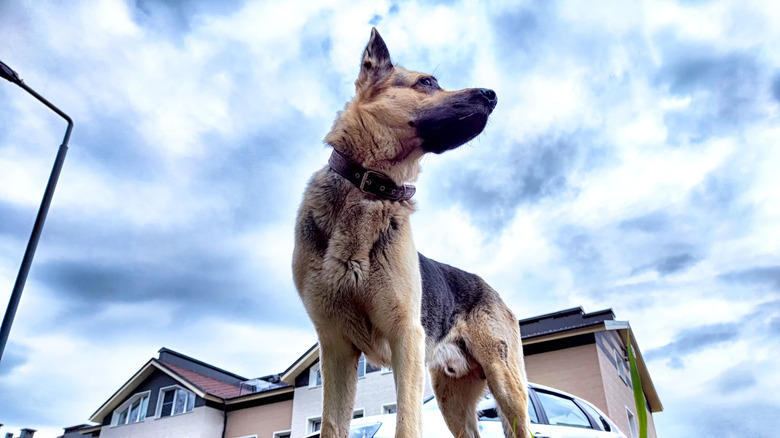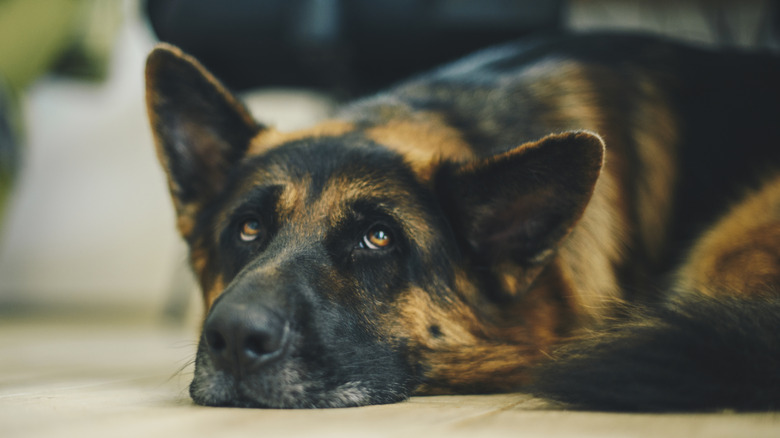What Life Is Really Like For Police Dogs
While the exact number of police dogs remains unreported, states like Michigan, with its 40 dedicated teams, show the prevalence of these canines across the states. The high-demand position has also helped highlight the remarkable traits of certain breeds. The intelligence, athleticism, and multi-faceted skill set of German shepherds make them adept at aiding in drug busts and criminal apprehension. Meanwhile, Labrador retrievers thrive in detection roles because of their social nature, strong sense of smell, and ease of training.
While human officers rely on the natural strengths of such canines to help them protect and serve, the work does not necessarily come naturally. A active police dog must undergo strict training beyond what household pets receive, including learning patience, cultivating targeted skills to tackle various tasks, and fostering a diligent work ethic. In turn, they reap the rewards of a supportive home life, the joy of a job well done, and eventual retirement to enjoy their golden years.
Aspiring police dogs need certain qualities to make it through early training
Stephen Scott, a U.S. army veteran and the owner of Scott's Police K-9, advised Police Magazine about selecting viable candidates for the force, stating, "You are looking for an all-around stable dog with an intense willingness to work in any environment; a dog that shows confidence in any situation." He further stressed that sociability and calmness in unique situations are essential: "If they can walk into a room they've never been in before with people they've never seen before and are comfortable in that environment, they are confident dogs."
Before a police dog can settle into the daily routine of a working canine, it must undergo strict training to ensure it can perform well. It typically takes around six months for a dog to complete basic training, but the time frame may vary depending on the adaptability or stubbornness of a particular canine. A puppy may enter training once it hits 8 weeks of age, with many trainers introducing basic commands as early as 6 weeks. According to the United States Police Canine Association, essential lessons include basic on/off leash obedience, agility work, recovering evidence in small grassy areas, runaway apprehension exercises, searching for suspects in open areas and buildings, and odor detection.
Ongoing specialized instruction can extend the base curriculum to two or more years. The specialized duties of police dogs include tracking and apprehending suspects, detecting dangerous substances, or aiding search and rescue efforts.
K-9s put their training to the test on patrol
Patrol dogs have one of the most hazardous jobs of any canine unit, tasked with chasing and pinning down suspects. Because the canines deal with dangerous individuals and often get called in for the express purpose of helping capture these individuals, injuries can occur on a regular basis. As a result, working together and strong communication are essential for K-9 units.
Writing for Police K-9 Magazine (via Police1), law enforcement officer and suspect tactics and perimeter containment expert Jack H. Schonely highlighted that when pursuing a dangerous criminal, deploying a canine unit first can help avoid harm to police officers. In order to ensure the safety of everyone involved and minimize risk to the dog, canines learn many different commands, ranging from "attack" to the more general "find narcotics." Canines must adhere to orders in tense situations and have the ability to obey their owners fully to ensure success.
Most police dogs need to know dozens of commands in both English and German. While the latter inclusion my come as a surprise, handlers often communicate with their dogs in German for a few reasons. Notably, many early police canines received training in Germany in the 1920s, making it the preferred language for commands to keep them consistent when the working dogs came to the U.S. Additionally, the continued use of a foreign language allows a canine to pay better attention to its owner and avoid getting distracted by the words of others during dangerous scenarios.
Police dogs help detect illicit and dangerous substances
Police officers rely on a canine's powerful sense of smell (facilitated by around 300 million olfactory receptors) to help analyze and process a wide range of scents dogs can detect but humans can't. Certain breeds, like German shepherds, Labrador retrievers, and Belgian shepherds, tend to thrive in bomb detection due to their ability to stay on task even with a lot of excitement unfolding around them. Bomb-detecting dogs learn to zero in on scents that indicate explosives, earning treats when they identify a smell successfully. Still, staying alert on bomb duty can prove exhausting; handlers look for signs of flagging dogs, swapping them when they grow too tired.
Training a canine to sniff for drugs involves associating narcotics with one of its preferred items (such as toy), making them keen to track it down when asked. Such dogs complete months of instruction and practice, eventually transitioning to a schedule of continued education. As a canine goes from rookie to pro, it learns how to react in a scenario-appropriate manner when it finds something, such as sitting and waiting patiently or vocalizing a discovery. A well-trained detector dog has the ability to adapt to the situation, using passive signs in crowded areas such as schools and airports so as not to upset the public while keeping itself safe.
Some canines aid in search and rescue missions
Dogs who work in search and rescue have a different routine than their patrolling and bomb-sniffing counterparts; as a result, they need to have the ability to work for a minimum of eight hours. A SAR (search and rescue) dog must also have a friendly and approachable manner so it doesn't frighten any adults or children requiring assistance. Handlers also teach their SAR canines to navigate a variety of terrains and scenarios that they could encounter on the job. The IAABC (International Association of Animal Behavior Consultants) lists several potential disciplines for SAR dogs, including searching for human scents, tracking a specific scent given to them by their handlers, human remains detection, and disaster rescues.
SAR dogs also differ from other working dogs by learning intelligent disobedience. This technique involves purposely disobeying their handlers at times, such as refusing to leave an area to reiterate that they have found something. Because of the requirements, the majority of SAR dogs function as volunteers, with the owners covering the expenses instead of working as part of a police force. Some law enforcement teams, like the Toronto Police Service, train their own SAR dogs, with handlers often having one general working canine and another that specializes in tasks such as search and rescue.
Police dogs receive continued education and training
After making it through selection and initial instruction, a K-9 must continue training. Federal recommendations encourage 16 hours per month, but standards vary across precincts; for example, the Salt Lake City Police Department requires its dogs to undergo two hours of in-service training for each 10-hour shift they complete.
Sgt. Melinda Ruopp, known for her work with police dogs during her time with the Marshalltown Police Department, outlined her process for continued training for the United States Police Canine Association. "Training days should be an opportunity to throw something at the dog that they have never done before," she shared. "Even if it is a small tweak to an existing skill." Additionally, she highlighted five keys of training focus: creating practice scenarios and exercises, legal considerations to ensure dogs don't behave in a way that can cause issues for the department, working on core components of the job, addressing areas a canine may struggle with, and certification preparation.
While certification criteria varies by state and is not always necessary, it has become a recommended practice for most police departments. Proper certification helps protect the hard-working police dog and law enforcement, as a canine without proof of continued education can have its competency called into question in a court case. An evolving police force also requires continued education. Notably, in 2013, the Connecticut State Police began teaching its K-9 to sniff out electronic storage devices used to share illegal material.
Even at home, K-9s must adhere to strict requirements
Speaking with Dogster, Officer Mark Wyrick of the Fontana Police K-9 unit in California shed some light on the home life of police canines. As the handler of a veteran police dog (a Belgian Malinois named Sargent), Wyrick takes responsibility for his partner on and off duty. At home, Sargent has a kennel outside and a crate indoors and gets the opportunity to interact with the family and relax. However, while there are some similarities, police dogs don't receive the same treatment as regular pets due to the strict guidelines of law enforcement.
When Wyrick leaves the home, Sergeant must stay in his crate or kennel until he returns. Wyrick also highlighted the dog's well-being and conditioning as essential, noting, "We monitor his weight just like an athlete to ensure he is ready for work and any potential task." When commenting on his home care routine, the officer added, "I groom him myself with baths every month and inspect him daily to ensure no health issues arise." A working dog's home life balances care, service requirements, and maintaining the bond with its handler to keep it fit for duty.
It's not always easy for a police dog to transition to retirement
Police work produces stress for both humans and their canine counterparts, and retirement for a hard-working dog can come as early as 7 years old, with a few making it to 11. Their service often comes with significant stressors which may lead to depression, separation anxiety, PTSD, or aggression, according to The Spruce Pets. Often, they require more training and, in some cases, resocialization, to adjust to everyday life. Yet, these challenges also offer the chance to allow a working dog to enjoy their later years and live a more pampered and quiet life.
Many departments have a policy in place whereby the public can adopt retired police dogs only when their handlers cannot take them in themselves. Police officers also tend to have early access to adopting would-be K-9s that did not make it through their initial training. This quick route to adoption means that once a police dog turns in its badge, it can spend the rest of its days with its handler or an officer who understands the need to honor its remaining days for its hard work.
